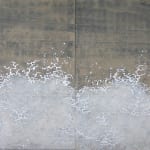Ken Matsubara Japanese, 1948
H180 x W1125 cm
(Set of 3 panels)
Further images
-
(View a larger image of thumbnail 1
)

-
(View a larger image of thumbnail 2
)

-
(View a larger image of thumbnail 3
)

-
(View a larger image of thumbnail 4
)

-
(View a larger image of thumbnail 5
)

-
(View a larger image of thumbnail 6
)

-
(View a larger image of thumbnail 7
)

-
(View a larger image of thumbnail 8
)

-
(View a larger image of thumbnail 9
)

-
(View a larger image of thumbnail 10
)

-
(View a larger image of thumbnail 11
)

-
(View a larger image of thumbnail 12
)

-
(View a larger image of thumbnail 13
)

-
(View a larger image of thumbnail 14
)

-
(View a larger image of thumbnail 15
)

-
(View a larger image of thumbnail 16
)

-
(View a larger image of thumbnail 17
)

-
(View a larger image of thumbnail 18
)

-
(View a larger image of thumbnail 19
)

Matsubara painted this monumental composition of Venus and the rising sun on a set of twelve sliding doors, or fusuma. The scene is inspired by the life of the great Buddhist monk Kūkai (774–835), who as a young man retreated to an ocean side cave where he watched the cycles of the sun and the moon as he strove toward spiritual awakening. Kūkai frequently recited the Akasagarbha sutra; a text evoked through the image of Venus which represents the Bodhisattva Akasagarbha, known in Japanese as Kokūzō. The set was originally commissioned for Jingoji, the Shingon temple in Kyoto where Kukai resided after returning from China, where he studied esoteric Buddhism. Before he began painting, Matsubara wrote Kūkai’s poem Hizō-hōyaku (Precious Key to the Secret Treasury), an explanation of the tenets of Shingon Buddhism, across the panels. He then coated the panels with an earthy-red bengara oxide to give the black ink and gold of the sky and stars a sense of texture. The crashing waves were painted with an undulating layer of clay-resin paint highlighted with thick lines of mica resin. The painting’s earthy, mundane elements pair with its celestial composition to suggest the interconnected nature of reality and humanity’s ability to transcend the boundaries between the body and the mind.


















